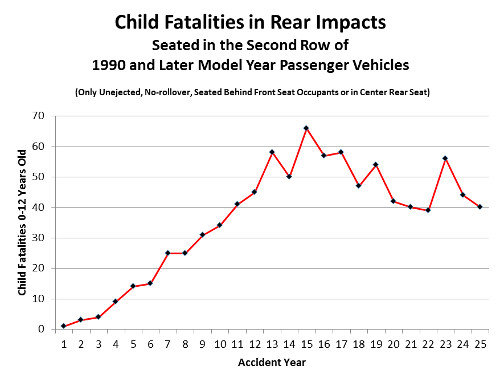Seat Back Failures: Who Has The Power? & Who Has the Responsibility?
March, 2016
Please watch this excellent video and report by CBS News on Seat Back Failures.
The failures of both government and industry to protect the public from foreseeable tragedies – for decades – are described. See
![]()
NHTSA Urged to Warn Parents of Seatback Collapse Dangers to Children in Rear Seats & How to Reduce Risk While Keeping Children in Rear
March 9, 2016(202)328-7700
The Center for Auto Safety (CAS) today petitioned the National Highway Traffic Safety Administration (NHTSA) to “take action to protect children riding in the rear seats of vehicles from the risk of being killed or severely injured when struck by a collapsing front seatback in a rear-end crash.” The petition asks NHTSA to warn parents as follows:
If Possible, Children Should Be Placed In Rear Seating Positions Behind Unoccupied Front Seats. In Rear-End Crashes, The Backs Of Occupied Front Seats Are Prone To Collapse Under The Weight Of Their Occupants. If This Occurs, The Seat Backs And Their Occupants Can Strike Children In Rear Seats And Cause Severe Or Fatal Injuries
As the petition states, “The problem underlying the need for the warnings sought by petitioner is, of course, the poor performance of seatbacks in rear-end crashes, and of serious inadequacy of the federal motor vehicle standard, FMVSS 207, which specifies minimum seat and seatback crash performance levels.” Attached to the petition is a timeline, “Collapsing Seatbacks And Injury Causation: A Timeline Of Knowledge,” which summarizes “the history of manufacturer and NHTSA inaction to ensure that in rear-end crashes, front seats provide adequate protection not only for their occupants but for people in the rear seats behind them.”
Separately, the Center filed a detailed analysis of lawsuits, police reports and litigated cases that shows the dangers of seat back collapse are far greater than what the agency recognizes because seat back collapse is not captured by the FARS database on which the agency has relied for all too long to deny there is a seatback collapse danger. FARS does not provide any information on seat back collapse. Out of 64 seat back collapse death and injury crashes, the Center only found 2 where the police report referenced seat back collapse.
For many years NHTSA has urged parents to place children in the rear seats of cars because of the risk that in the front seat, they might be injured by inflating airbags in frontal crashes. But the “unintended consequences” of this policy, the petition notes, has been to “expose them to another kind of hazard – that of being struck or crushed when the back of a front seat occupied by an adult collapses rearward… Until cars on the American highway are equipped with adequately strong front seats and seatbacks, children in rear seats behind occupied front seats will continue to be in danger of death or severe injury from front seatback failures in rear-end impacts.”
The petition reports on the results of an analysis of NHTSA data by Friedman Research Corp. Done at the Center’s request, the analysis shows that over the twenty-four year period 1990-2014, nearly 900 children seated behind a front-seat occupant or in a center rear seat died in rear impacts of 1990 and later model-year cars.

As the Timeline shows, NHTSA has frequently been alerted to the hazards of weak designs and inadequate federal performance standards for seats and seatbacks. “Papers published by the Society of Automotive Engineers as early as 1967 described the need for adequate of front-seat crashworthiness in graphic and alarming terms. A poorly designed car seat ‘becomes an injury-producing agency during collision,’ said one. Another stated, ‘…a weak seatback is not recognized as an acceptable solution for motorist protection from rear end collisions.’”
In 1974, the petition notes, NHTSA announced its intention to develop a new standard “covering the total seating system” and requiring dynamic rear-impact crash testing. But thirty years later, in 2004, it abandoned the plan, saying it needed “additional research and data analysis” and leaving in place the woefully weak requirements of FMVSS 207, a standard which has not been upgraded since its adoption in 1967. In a research study of 30-mph rear crashes done one year earlier which is not cited in the rulemaking termination, NHTSA researchers warned of the danger to children placed in rear seats at NHTSA’s recommendation. “Further, fatalities and injuries to rear child occupants due to seat back collapse of the front seat in rear impacts have also been reported. This is especially of concern since NHTSA recommends to the public that children of age 12 and under should be placed in the rear seat.”
In its conclusion, the petition states that warning parents of the hazards of front seatback collapse to children in rear seat is an essential measure “made necessary by the continued absence of a federal motor vehicle safety standard requiring that cars be equipped with adequately protective front seats.” The agency “can take most of the requested steps on its own, without time-consuming rulemaking, and should do so promptly,” the petition notes.
# # #
CAS Petitions NHTSA to Warn Parents of Seat Back Failure Dangers to Children in Rear Seats
CAS Letter to NHTSA Administrator Rosekind
Collapsing Seat Backs and Injury Causation: A Timeline of Knowledge
Friedman Study: Child Fatalities in Rear Impacts
NHTSA Seat Back Rulemaking History
Clarence Ditlow
Executive Director
Center for Auto Safety
1825 Connecticut Ave NW #330
Washington DC 20009
